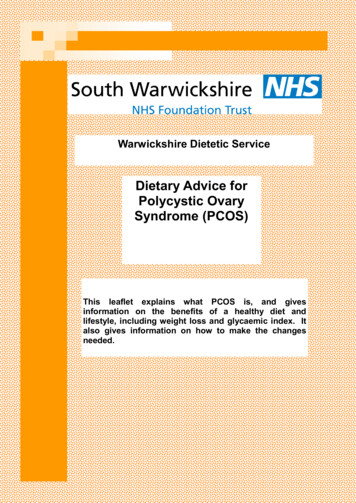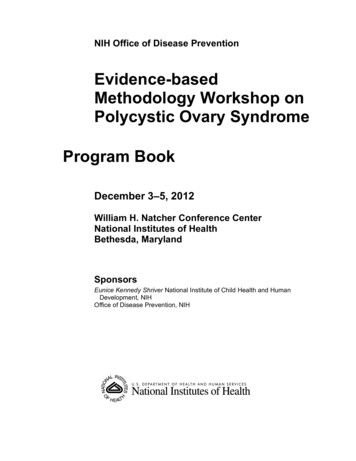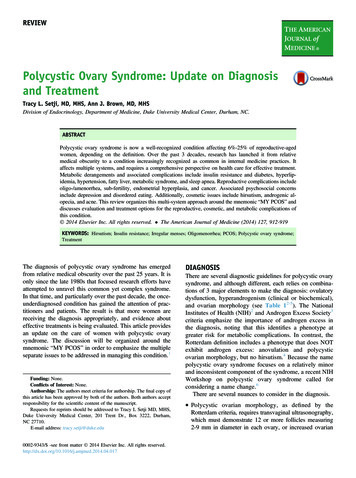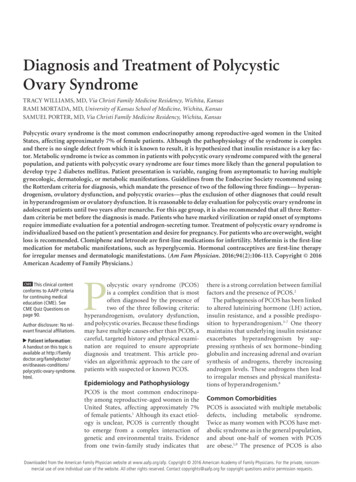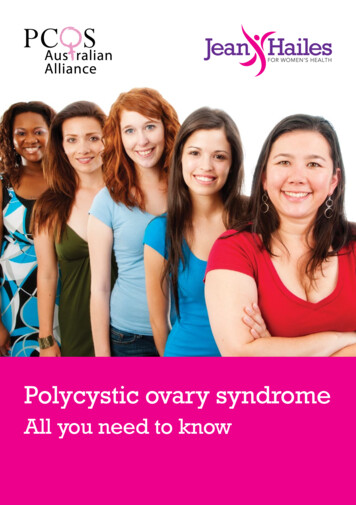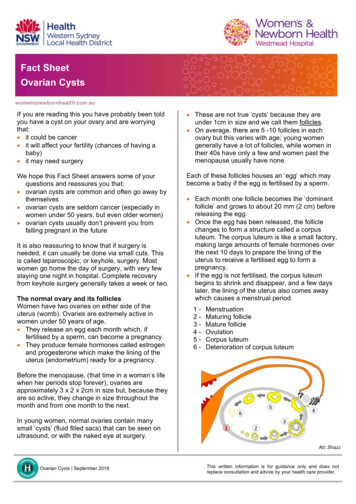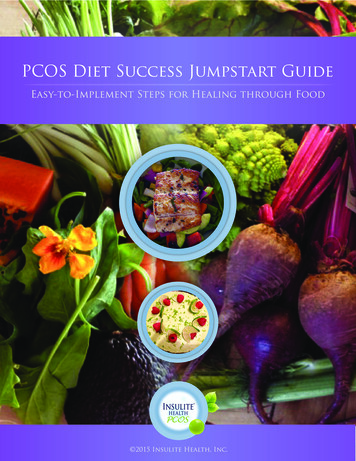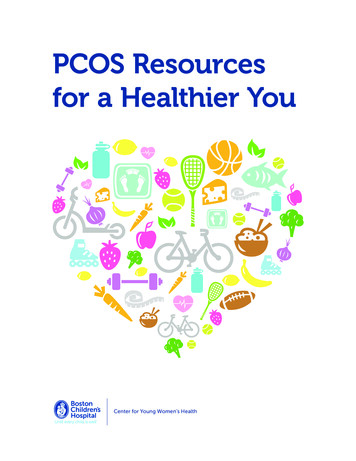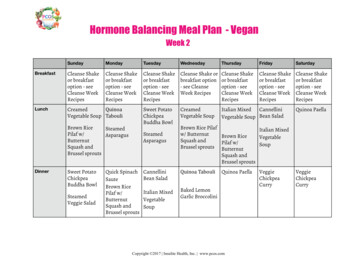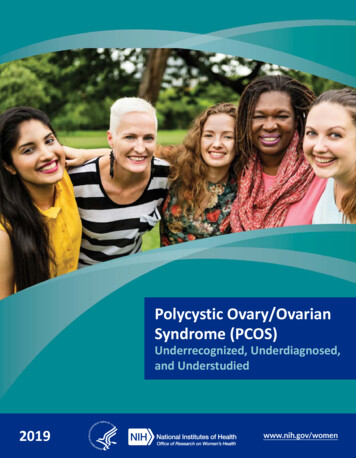
Transcription
Polycystic Ovary/OvarianSyndrome (PCOS)Underrecognized, Underdiagnosed,and Understudied2019www.nih.gov/women
AcknowledgmentsThis informational booklet was developed as part of Lt. Col. Dr. Kim Hopkins’ postdoctoral training with Dr.Samia Noursi at ORWH. Many thanks to special volunteers Nathan Dinh (University of Richmond) and BaniSaluja (University of Maryland), who played a major role in compiling the information in this booklet.Table of ContentsSection I: What is PCOS? . 1Section II: Defining PCOS through the years . 2Section III: Signs of PCOS . 3Section IV: Risk factors and preventive measures . 6Section V: Further information for health careproviders and researchers . 8Section VI: Economic impact . 9Section VII: How NIH is addressing PCOS . 10Section VIII: Conclusion . 11Section IX: Definitions . 12References . 13ii
Polycystic Ovary/Ovarian Syndrome:Underrecognized, Underdiagnosed, and UnderstudiedSection I: What is PCOS?Polycystic ovary/ovarian syndrome (PCOS) is a set of symptomsrelated to an imbalance of hormones that can affect women andgirls of reproductive age.1–7 It is defined and diagnosed by acombination of signs and symptoms of androgen excess,ovarian dysfunction, and polycystic ovarian morphology onultrasound.2This informational booklet provides guidance for those whoare concerned that they may have PCOS and those who havealready been diagnosed. There is also information on currentefforts to understand and treat PCOS.*At least 70%of women with PCOSremain undiagnosed inprimary care*Tomlinson, J. A., Pinkney, J. H., Evans, P., Millward, A., & Stenhouse, E. (2013). Screening for diabetes andcardiometabolic disease in women with polycystic ovary syndrome. The British Journal of Diabetes & Vascular Disease,13(3), 115–123. doi:10.1177/14746514134955711
Section II: Defining PCOS through the yearsTo better understand what PCOS is, it is important to know how PCOS is defined and categorized. Althoughit is called polycystic ovary/ovarian syndrome, PCOS is not primarily defined by ovarian cysts.8 Rather,PCOS is defined by the presence of at least two of three diagnostic criteria. These diagnostic criteria havebeen defined three separate times—by the National Institutes of Health (NIH) in 1990, by the EuropeanSociety of Human Reproduction and Embryology (ESHRE) and the American Society for ReproductiveMedicine (ASRM) in 2003 (also known as the Rotterdam criteria), and by the Androgen Excess and PCOSSociety (AE-PCOS) in 2006. In 2012, NIH endorsed the 2003 Rotterdam criteria for PCOS. See the variousdefinitions below:CriteriaNIH 1990ESHRE/ASRM(Rotterdam) 2003AE-PCOS 2006NIH 2012acceptance ofRotterdam 20032 of 2 required2 of 3 required2 of 3 required2 of 3 requiredHyperandrogenismOvarian dysfunctionPolycystic ovarianmorphologyExclusion of conditionsthat mimic PCOSSpecific disorders with signs and symptoms that overlap with those of PCOS must be ruled out for anaccurate PCOS diagnosis. These include hyperprolactinemia, non-classic congenital adrenal hyperplasia,and Cushing’s syndrome. Because of the diagnostic challenges involved with PCOS, primary care providersmight recommend seeing a gynecologist, which is a doctor who specializes in the health of a woman’sreproductive system, an endocrinologist, which is a doctor who specializes in hormones, or a reproductiveendocrinologist, which is a doctor who specializes in a woman’s reproductive system, hormones, andinfertility.2
Section III: Signs of PCOSDermatological FeaturesHirsutismBaldingOily skinAcneSkin discoloration(acanthosis nigricans)High levels of androgens typically lead to various dermatological symptoms.9,10 These includehirsutism (coarse and dark hair on the body areas where men typically grow hair—e.g., theface, abdomen, chest, and back), acne, and balding/alopecia. In adolescents, some of thedermatological symptoms may be caused by puberty rather than PCOS.Menstrual ual disorders may vary, from complete absence of menstruation (amenorrhea) tomenstruation delayed to 35 days or more (oligomenorrhea) to heavy bleeding (menorrhagia).Women with irregular menstrual periods have a 91% chance of having PCOS.11 Those with PCOSare 15 times more likely to report infertility.123
Polycystic OvariesUterusNormal ovaryEnlarged ovaryExcessive follicles(magnified)Excessive follicles, which is defined as 25 or more follicles that are 2 mm to 10 mm in a singleview of a transvaginal ultrasound, may be present in PCOS. Additionally, increased ovarianvolume, an ovary that is more than 10 mL, may be present.a. Health implicationsPCOS Affects Many Areas of a Woman’s LifeDermatologicalhirsutism, acnePsychologicalanxiety, depressionSleepdisordered sleep,sleep apnea4Metabolicobesity, metabolicsyndrome, insulinresistance, type arriage
b. An international disease in many formsBetween 5% and 26% of women are affected by PCOS, depending on the diagnostic criteria applied.4,13Women throughout the lifespan are at risk of being affected by PCOS, and women from all regionsof the world—including Australia,14 China,15 Denmark,16 Greece,17 India,18 the Netherlands,19 Spain,4the United Kingdom,20 and the U.S.1—have reported cases of PCOS. There are conflicting resultsconcerning differences in PCOS rates by race, but severity and expression of symptoms may vary basedon environmental factors.21,22 Understanding differences in symptoms among different racial and ethnicgroups can help with the diagnosis: Relatively mild in White women Higher body mass index (BMI) in Whitewomen, especially in North America andAustralia More severe hirsutism in Middle Eastern,Hispanic, and Mediterranean women Increased central adiposity, insulin resistance,diabetes, metabolic risks, and acanthosisnigricans (dark discoloration in body folds andcreases) in Southeast Asians and indigenousAustralians Lower BMI and milder hirsutism in East Asians Increased prevalence of metabolic syndromein Black adolescents and young adultswith PCOS compared with their Whitecounterparts23 Higher BMI and metabolic features in Africansc. Across the lifespanWomen who are affected by PCOS are at risk for chronic disease progression, which carries significantpublic health implications across the lifespan:AdolescenceDiagnosing PCOS in adolescents is difficult because PCOS and puberty have similar features. Theseinclude irregular menstrual cycles and acne. For an accurate diagnosis, adolescents should have allthree elements of the Rotterdam criteria for PCOS. Hyperandrogenemia is the main marker for PCOSin adolescents.7 Oligomenorrhea or amenorrhea should be present for at least 2 years after the firstperiod. Forty percent of adolescents with menstrual irregularity have polycystic ovaries.Reproductive ageFertility issues and hirsutism are the primary issues for women at reproductive ages. Infertility iscaused by high levels of androgen and luteinizing hormones, which can lead to irregular menstrualcycles and anovulation, which is an absence of ovulation during a menstrual cycle.24 Women withPCOS have three to four times the rate of pregnancy-induced hypertension and preeclampsia.24 Thereis also a significantly increased risk of endometrial cancer in women with PCOS.25Late reproductive to menopausal ageIn addition to endometrial cancer, women over 54 years of age with PCOS were found to have asignificant risk of ovarian cancer, though the risk for breast cancer is not significantly increased byhaving PCOS.25 Older women with PCOS have a fourfold to sixfold increase of diabetes compared withwomen without PCOS.7 Older women with PCOS also have more severe hirsutism, in addition to anincreased number of metabolic and cardiovascular risk factors.265
d. Obesity and cardiovascular risksThe metabolic abnormalities caused by PCOS, specifically increased abdominal fat and insulin resistance,contribute extensively to increased risk of type 2 diabetes and cardiovascular disease. For women withPCOS, 50–80% have insulin resistance,5 61% are overweight or obese,27 and 50% become prediabetic ordiabetic before age 40.28e. Psychosocial implicationsIn addition to physical symptoms, women with PCOS are at an increased risk of experiencing mental healthissues, including anxiety and depression associated with infertility, obesity, and hirsutism.291.Anxiety. Anxiety has been found to be significantly higher in women with PCOS compared withcontrols.30-32 PCOS may introduce an additional layer of complexity to the psychological profile andshould be considered when evaluating the mental health of women.2.Depression. The prevalence and risk of depression and depressive disorders in women with PCOSare 40–64%, significantly higher than in women without PCOS.33,34 Women with PCOS are fourtimes more likely to be at risk for depression compared with women without PCOS.35f. Coping with worries about having PCOSIf you’ve been told you have PCOS, you may feel frustrated or sad.36 Also, you may feel relief that there arereasons and possible treatments for the symptoms you have been having such a hard time dealing with—e.g., keeping a healthy weight, hirsutism, acne, or irregular periods. It can be difficult having a diagnosiswithout an exact cure. However, it’s important for women with PCOS to know they are not alone. Findinga support network and a health care provider who knows a lot about PCOS and is someone you feelcomfortable talking with is very important. Even though results may take a long time, it is important tokeep working on a healthy lifestyle and not let PCOS get you down. Many women with PCOS report thattalking with a counselor about their concerns can be helpful.36Section IV: Risk factors and preventive measuresWhat factors increase the likelihood of developing PCOS? There are four main risk factors:a. GeneticsIf a close family member, such as a sister or mother, has the condition, you havean increased, but not guaranteed, chance of developing PCOS.37,38 Even without afamily history of PCOS, there are other risk factors that can lead to its development.b. DietAdditionally, diet has been found to be a contributing factor for PCOS. Fats and proteins from one’s dietcan form advanced glycation end products (AGEs) when exposed to sugar in the bloodstream.39 Thesecompounds are known to contribute to increased bodily stress and inflammation, which have been linkedto diabetes and cardiovascular disease.40 PCOS patients already have an increased likelihood for metabolicsyndrome, cardiovascular issues, and diabetes. Thus, it’s best to limit exposure to AGEs. Animal-derivedfoods that are high in fat and protein are generally AGE-rich and prone to more AGE formation duringcooking. In contrast, foods that are low on the glycemic index—such as vegetables, fruits, whole grains,and milk—contain relatively few AGEs, even after cooking.406
c. LifestyleEveryday habits greatly affect the development and severity of PCOS. Obesity is widely recognized as aggravating PCOS, so managing a healthy weight, especially abdominalcircumference, is recommended.41 Exercise helps to reduce many PCOS symptoms, such as depression, inflammation, and excess weight.Aim to incorporate exercise into your lifestyle.41 The Centers for Disease Control and Prevention (CDC)recommends 150 minutes (2 hours and 30 minutes) of moderate-intensity exercise per week or 75minutes of high-intensity exercise per week and incorporating strength training 2 days per week.42 In addition to exercise, increase daily activity by taking the stairs, going on short walks, and stretchingthroughout the day. No matter the movement, stay consistent and choose an enjoyable activity. Women may want to limit inflammatory foods—such as dairy products, foods with gluten, and foodshigh in glycemic load, such as potatoes, white bread, and sugary desserts—as much as possible.43 But ifthose foods do not cause bodily aggravation, then there is no need to eliminate them completely.d. Environmental exposure risksEnvironmental exposures to endocrine-disrupting chemicals may lead to female reproductive healthissues, including PCOS. Research shows that endocrine-disrupting chemicals may pose the greatestrisk during prenatal and early postnatal development, when organ systems are developing. Endocrinedisrupting chemicals can be found in many of the everyday products we use, including some plasticbottles and containers, liners of metal food cans, detergents, flame retardants, food, toys, cosmetics,and pesticides. Limiting personal exposure to endocrine-disrupting chemicals may benefit reproductivehealth.44Long-term medical follow-upsIt’s important to follow up regularly with your health care provider and make sure you take all themedications prescribed to regulate your periods and lessen your chances of developing additional chronicdiseases. Because women with PCOS have a higher chance of developing diabetes and having other healthproblems,45 your health care provider may suggest having a: Blood sugar test once a year Hemoglobin A1C test (a test that tells how high yourblood sugar has been the past 2–3 months) once ayear or a glucose tolerance test every few years Vitamin D level test Thyroid function test7
Section V: Further information for health careproviders and researchersa. Lack of awareness and diagnosesThe existence of multiple diagnostic criteriahas made it difficult for health care providersto accurately and consistently diagnosewomen with PCOS.46 This in turn causespatients to be dissatisfied with the diagnosticexperience. In an international survey of1,385 women, only 35% of women weresatisfied with their diagnostic experience.47And 84% of women were dissatisfied withthe information provided by their health careproviders about PCOS and its symptoms.47Some health care providers are less awareof the various diagnostic criteria andphenotypes of PCOS.47 Increased awarenessof PCOS, its causes, and its symptoms mayhelp the process of diagnosis and bring appropriate subsequent care. As a resource for patients and healthcare providers, there are international evidence-based guidelines for the assessment and management ofPCOS published by researchers at Monash University in Australia. They fully endorse the Rotterdam PCOSdiagnostic criteria in adults, which help serve as a PCOS diagnostic tool for medical professionals.22b. Possible phenotypesPhenotypes are the observable characteristics of an individual. Women with PCOS can have anycombination of the following phenotypes: excess androgen levels, ovarian dysfunction, and polycysticovarian morphology. The table below depicts the possible phenotypes from the different combinations3:PhenotypeHyperandrogenismOvarian dysfunctionPolycystic ovarianmorphologyType AType BType CType DType A is the most severe phenotype, and D is the least severe phenotype. Types A and C are the mostprevalent phenotypes.488
c. Treatment optionsCurrently, there is no cure for PCOS, but symptoms can be managed with lifestyle changes andmedications. Increasing daily activity—along with eating a high-fiber, low-sugar diet with lots ofvegetables, whole grains, and fruits—will help to reduce excess weight and maintain a healthy waistcircumference.41 Also, avoiding or reducing intake of processed foods, trans fats, and saturated fats helpsto maintain stable blood sugar levels.49 Consider consulting a nutritionist or dietitian. Furthermore,quitting smoking (or never starting) will also improve overall health.In addition to these lifestyle changes,there are medications that can help withthe management of PCOS, which shouldbe tailored to each individual’s riskprofile, desires, and treatment goals:50 Low-androgen oral contraceptivesthat contain drospirenone orprogestin-only pills, known asminipills51 An inositol supplement (myoinositol, D-chiro-inositol, or acombination of the two), whichcan help manage PCOS symptoms,such as hirsutism, acne, difficultyconceiving, etc.52 Metformin Lipid-lowering agents for womenwith lipid abnormalitiesSection VI: Economic impactThe cost associated with PCOS derives from treatment ofsymptoms, including type 2 diabetes ( 1.77 billion),menstrual dysfunction ( 1.35 billion), and hirsutism( 622 million).53 In comparison, the U.S. health caresystem spends 237 billion every year to treat diabetesand 199 billion on heart disease and stroke.54 A team ofresearchers published a study on the economic impactof PCOS in 2005; see the reference immediately below.**(This was the most up-to-date study on the economic impactat the time of the publication of this booklet.)** 4.36 billionEstimated annual cost of PCOSto the U.S. health caresystem in 2005**Azziz, R., Marin, C., Hoq, L., Badamgarav, E., & Song, P. (2005). Health care-related economic burden of the polycysticovary syndrome during the reproductive life span. Journal of Clinical Endocrinology and Metabolism, 90(8), 4650–4658.doi:10.1210/jc.2005-06289
Section VII: How NIH is addressing PCOSPCOS has been addressed by several institutes acrossthe National Institutes of Health (NIH), including theEunice Kennedy Shriver National Institute of ChildHealth and Human Development (NICHD). Through itsintramural and extramural organizational units, NICHDsupports and conducts a broad range of research to learn more about the causes of PCOS, its risk factors,and its possible treatments. Though research has demonstrated that PCOS has not just reproductive butalso metabolic and mental health manifestations, NICHD funds PCOS research with a particular focus onreproductive health. See more at https://www.nichd.nih.gov/health/topics/pcos.The National Institute of Environmental Health Sciences(NIEHS) has also provided significant contributionsin the field of PCOS through its funding support inintramural and extramural research. The studiesfunded by NIEHS focus on environmental factors thatmay play a significant role in the development of PCOS. These include exploring the role of estrogensignaling dysfunction in PCOS development,55,56 the origin of theca cells and the effects of irregulardifferentiation,57,58 and environmental factors and genetic predispositions for PCOS through a largemultiphase study involving twin sisters.59,60 NIEHS efforts focus on causes and origins of PCOS and thedevelopment of treatments and preventive measures.The National Institute of Diabetes and Digestive andKidney Diseases (NIDDK) is studying the effects oflifestyle changes on prediabetes metabolic syndromeand insulin resistance, for which PCOS is a risk factor.On December 21, 2017, the U.S.Senate passed S. Res. 336 byunanimous consent, recognizing theseriousness of PCOS. The resolutionencourages States, territories,and local governments to supportincreasing awareness of PCOS;educate women, girls, health careprofessionals, and the general public;improve efforts to diagnose andtreat PCOS; and improve the qualityof life and outcomes for womenand girls with PCOS. The resolutionalso recognizes the need for furtherresearch, improved treatment andcare options, and a cure for PCOS,acknowledging the struggles affectingall women and girls afflicted withPCOS residing within the U.S.10
Section VIII: ConclusionNIH has conducted valuable research on PCOS. Yet there are critical gaps remaining in the understandingof this disorder, such as the connections of comorbidities to PCOS. Women with PCOS make up the largestgroup of women at risk for developing type 2 diabetes and cardiovascular disease. They are also at athreefold greater risk for developing uterine cancer. In addition, women with PCOS are at higher risk formental health disorders—such as anxiety and depression. Because of the serious effects that PCOS canhave on many aspects of health, collaborative research efforts will be essential for advancing diagnosisand treatments and reducing the suffering of women with this disorder.ResourcesThere are many efforts to address PCOS across the country, including efforts by the American Societyfor Reproductive Medicine, the American College of Obstetricians and Gynecologists, and the AndrogenExcess and PCOS Society. Another noteworthy organization is PCOS Challenge: The National PolycysticOvary Syndrome Association. It is a 501(c)(3) nonprofit support and advocacy organization for women andgirls with polycystic ovary syndrome. PCOS Challenge’s mission is to raise public awareness of PCOS andhelp PCOS patients overcome their symptoms and reduce their risk for life-threatening related diseases,such as diabetes, cardiovascular disease, and cancer. The organization’s goal is for PCOS to be treated asa public health priority. Through its national advocacy initiatives, the PCOS Challenge shines light on theneed for increased awareness, improved and expanded access to care, and increased funding for PCOSresearch. It funds efforts to help fight PCOS and organizes the country’s largest conference dedicated toeducation and raising awareness, which typically occurs in mid-September.The PCOS Awareness Association (PCOSAA) holds another conference around the same time annually.PCOSAA is a worldwide nonprofit dedicated to advocacy for PCOS. The organization and its volunteersare raising awareness of this disorder and providing educational and support services to help peopleunderstand what the disorder is, teach people how it can be treated, and decrease the impact of itsassociated health outcomes.September is PolycysticOvary/Ovarian Syndrome(PCOS) Awareness MonthWorld PCOS Day is September 1 and marks the start of PCOS Awareness Month. If you see an abundanceof teal in September, note that it is the awareness color for the condition.11
Section IX: DefinitionsThe following definitions were taken or adapted from the NCI Dictionary of Cancer Terms, the NCIDictionary of Genetics Terms, the MedlinePlus Medical Dictionary, or NICHD:amenorrhea – The absence of a woman’s monthlymenstrual period. Occurs when a woman does not gether period by age 16 or when she stops getting herperiod for at least 3 months and is not pregnant.androgen – A type of hormone that promotesthe development and maintenance of male sexcharacteristics. Testosterone is one main type ofandrogen.cardiovascular disease – A broad term for problemswith the heart and blood vessels. These problems areoften caused by atherosclerosis and occur when fat andcholesterol are built up in blood vessel (artery) walls.cyst – A closed, saclike pocket of tissue that can formanywhere in the body. It may be filled with fluid, air,pus, or other material. Most cysts are benign (notcancerous).absorb glucose (sugar) for energy and to control theamount of sugar in the blood. Insulin resistance occurswhen cells in key metabolic tissues—liver, muscle, andfat—use insulin less effectively than normal. As a result,a person’s blood sugar level rises above a normal range,placing the person at risk for health problems such asdiabetes and kidney, eye, heart, and nerve disease.luteinizing hormone (LH) – A hormone made in thepituitary gland. In females, it acts on the ovaries to makefollicles release their eggs and to make hormones thatget the uterus ready for a fertilized egg to be implanted.In males, it acts on the testes to cause cells to growand make testosterone. Also called interstitial cell–stimulating hormone and lutropin.menorrhagia – Heavy menstrual periods or excessivebleeding.dyslipidemia – High levels of lipids (triglycerides orcholesterol) in the blood.oligomenorrhea – Having infrequent menstrualperiods—specifically, having periods that occur morethan 35 days apart.estrogen – A type of hormone that helps the bodydevelop and maintain female sex characteristics andthe growth of long bones. Estrogens are made by thebody but can also be made in a laboratory. They may beused as a type of birth control and to treat symptomsof menopause, menstrual disorders, osteoporosis, andother conditions.perimenopause – The time before menopause that maybegin several years before one’s last menstrual period.Signs of perimenopause include more frequent periodsat first and then occasional missed periods, periods thatare longer or shorter, and/or changes in the amount ofmenstrual flow.etiology – The cause or origin of a disease.follicle – A sac or pouchlike cavity formed by a group ofcells. In the ovaries, one follicle contains one egg. In theskin, one follicle contains one hair.follicle-stimulating hormone (FSH) – A hormone madein the pituitary gland. In females, it acts on the ovariesto make the follicles and eggs grow. In males, it acts onthe testes to make sperm. Also called follitropin.hirsutism – The growth of coarse dark hair abovethe lips or on the chin, chest, abdomen, or back thatresembles male-pattern hair growth.hyperandrogenism/hyperandrogenemia – Ovarianoverproduction of testosterone, leading to thedevelopment of male characteristics in a woman.insulin/insulin resistance (IR) – Insulin is a hormoneproduced by the pancreas. It is needed to help cells12phenotype – The observable characteristics in anindividual resulting from the expression of genes andinfluences of the environment; the clinical presentationof an individual with a particular genotype.theca cells – Endocrine cells associated with ovarianfollicles that play an important role in fertility byproducing the androgen needed for ovarian estrogenproduction.type 2 diabetes – The most common form of diabetes,a disease in which the body’s ability to produce orrespond to the hormone insulin is impaired, resultingin elevated levels of glucose (sugar) in the blood. Type2 diabetes is strongly associated with insulin resistanceand with subsequent dysfunction in normal pancreaticinsulin production. Risk factors for developing type 2diabetes include obesity, older age, belonging to certainracial or ethnic minority groups, and the presence ofother diseases, such as PCOS.
References1.Azziz et al., 2004. PubMed ID: 1518105237. Prapas et al., 2009. PubMed ID: 200110852.Trikudanathan et al., 2015. PubMed ID: 2545665238. Unluturk et al., 2007. PubMed ID: 173897703.Lizneva et al., 2016. PubMed ID: 272337604.Asunción et al., 2000. PubMed ID: 1090279039. Diamanti-Kandarakis et al., 2012.PubMed ID: 222295645.Orio et al., 2016. PubMed ID: 275758706.Fauser et al., 2012. PubMed ID: 221537897.Sir-Petermann et al., 2016. PubMed ID: 275104918.Escobar-Morreale et al., 2018. PubMed ID: 2956962142. U.S. Department of Health and Human Services,2018. Physical Activity Guidelines for Americans:2nd Edition9.Keen et al., 2017. PubMed ID: 2840554943. Bates et al., 2013. PubMed ID: 2326198310. Zhao et al., 2011. PubMed ID: 2176289011. Kumarapeli et al., 2008. PubMed ID: 1855055912. Joham et al., 2015. PubMed ID: 2565462613. Ding et al., 2017. PubMed ID: 2922121114. Boyle et al., 2012. PubMed ID: 2225693815. Chen et al., 2008. PubMed ID: 1837806116. Gottschau et al., 2015. PubMed ID: 2545169417. Diamanti-Kandarakis et al., 1999.PubMed ID: 1056664118. Nidhi et al., 2011. PubMed ID: 2160081219. Vink et al., 2006. PubMed ID: 1621971420. Michaelmore et al., 1991. PubMed ID: 1061998421. Wolf et al., 2018. PubMed ID: 3046327622. Teede et al., 2018. PubMed ID: 3003322723. Hillman, et al., 2014. PubMed ID: 2438237524. Bellver et al., 2018. PubMed ID: 2895197725. Barry et al., 2014 . PubMed ID: 2468811826. Glintborg et al., 2012. PubMed ID: 2238293427. Lim et al., 2012. PubMed ID: 2276746728. Ovalle et al., 2002. PubMed ID: 1205771229. Veltman-Verhulst et al., 2012. PubMed ID: 2282473530. Laggari et al., 2009. PubMed ID: 1953348631. Weiner et al., 2004. PubMed ID: 1518469532. Cooney et al., 2017. PubMed ID: 2833328633. Bhattacharya et al., 2010. PubMed ID: 1989665234. Kerchner et al., 2009. PubMed ID: 1824939835. Dokras et al., 2011. PubMed ID: 2117365736. Office on Women’s Health in the U.S. Department ofHealth and Human Services, 2018. “What is ive/pcos.html#worries40. Uribarri et al., 2013. PubMed ID: 2049778141. Patel, 2018. PubMed ID: 2967849144. Rutkowska et al., 2016. PubMed ID: 2755970545. Sharma et al., 2006. PubMed ID: 1677215546. Cree-Green, 2017. PubMed ID: 2835910847. Gibson-Helm et al., 2017. PubMed ID: 2790655048. Clark et al., 2014. PubMed ID: 2452008149. Salama et al., 2015. PubMed ID: 2625807850. Rachek, 2014. PubMed ID: 2437324051. Wang et al., 2016. PubMed ID: 2706403052. Unfer et al., 2017. PubMed ID: 2904244853. Azziz et al., 2005. PubMed ID: 1594421654. Centers for Disease Control and Prevention, 2019.Health and Economic Costs of Chronic Diseases55. Arnette et al., National Institute of EnvironmentalHealth Sciences, 2019. “Papers of the /dir/index.htm56. Arao et al., 2019. PubMed ID: 3086665557. National Institute of Environmental Health Sciences,2015. “NIH Study Solves Ovarian Cell Mystery,Shedding New Light on Reproductive m/releases/2015/may6/index.cfm58. Liu et al., 2015. PubMed ID: 2591782659. National Institute of Environmental Health Sciences.“Polycystic Ovary Syndrome in Twin Sisters” s/polycystic/index.cfm60. U.S. National Library of Medicine, 2017. “PCOS TwinStudy – Environmental Factors in the Developmentof Polycystic Ovary Syndrome, Phase 2” https://clinicaltrials.gov/ct2/show/NCT0044428813
For more information and resources,visit the ORWH page: www.nih.gov/womenPublication Number 19-OD-8095This publication was pu
Diet Additionally, diet has been found to be a contributing factor for PCOS. Fats and proteins from one’s diet can form advanced glycation end products (AGEs) when exposed to sugar in the bloodstream.39 These compounds are known to contribute to increas
